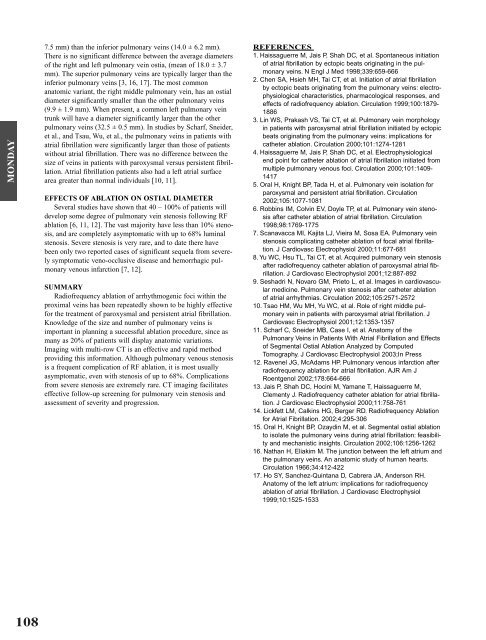Thoracic Imaging 2003 - Society of Thoracic Radiology
Thoracic Imaging 2003 - Society of Thoracic Radiology
Thoracic Imaging 2003 - Society of Thoracic Radiology
You also want an ePaper? Increase the reach of your titles
YUMPU automatically turns print PDFs into web optimized ePapers that Google loves.
MONDAY<br />
108<br />
7.5 mm) than the inferior pulmonary veins (14.0 ± 6.2 mm).<br />
There is no significant difference between the average diameters<br />
<strong>of</strong> the right and left pulmonary vein ostia, (mean <strong>of</strong> 18.0 ± 3.7<br />
mm). The superior pulmonary veins are typically larger than the<br />
inferior pulmonary veins [3, 16, 17]. The most common<br />
anatomic variant, the right middle pulmonary vein, has an ostial<br />
diameter significantly smaller than the other pulmonary veins<br />
(9.9 ± 1.9 mm). When present, a common left pulmonary vein<br />
trunk will have a diameter significantly larger than the other<br />
pulmonary veins (32.5 ± 0.5 mm). In studies by Scharf, Sneider,<br />
et al., and Tsau, Wu, et al., the pulmonary veins in patients with<br />
atrial fibrillation were significantly larger than those <strong>of</strong> patients<br />
without atrial fibrillation. There was no difference between the<br />
size <strong>of</strong> veins in patients with paroxysmal versus persistent fibrillation.<br />
Atrial fibrillation patients also had a left atrial surface<br />
area greater than normal individuals [10, 11].<br />
EFFECTS OF ABLATION ON OSTIAL DIAMETER<br />
Several studies have shown that 40 – 100% <strong>of</strong> patients will<br />
develop some degree <strong>of</strong> pulmonary vein stenosis following RF<br />
ablation [6, 11, 12]. The vast majority have less than 10% stenosis,<br />
and are completely asymptomatic with up to 68% luminal<br />
stenosis. Severe stenosis is very rare, and to date there have<br />
been only two reported cases <strong>of</strong> significant sequela from severely<br />
symptomatic veno-occlusive disease and hemorrhagic pulmonary<br />
venous infarction [7, 12].<br />
SUMMARY<br />
Radi<strong>of</strong>requency ablation <strong>of</strong> arrhythmogenic foci within the<br />
proximal veins has been repeatedly shown to be highly effective<br />
for the treatment <strong>of</strong> paroxysmal and persistent atrial fibrillation.<br />
Knowledge <strong>of</strong> the size and number <strong>of</strong> pulmonary veins is<br />
important in planning a successful ablation procedure, since as<br />
many as 20% <strong>of</strong> patients will display anatomic variations.<br />
<strong>Imaging</strong> with multi-row CT is an effective and rapid method<br />
providing this information. Although pulmonary venous stenosis<br />
is a frequent complication <strong>of</strong> RF ablation, it is most usually<br />
asymptomatic, even with stenosis <strong>of</strong> up to 68%. Complications<br />
from severe stenosis are extremely rare. CT imaging facilitates<br />
effective follow-up screening for pulmonary vein stenosis and<br />
assessment <strong>of</strong> severity and progression.<br />
REFERENCES<br />
1. Haissaguerre M, Jais P, Shah DC, et al. Spontaneous initiation<br />
<strong>of</strong> atrial fibrillation by ectopic beats originating in the pulmonary<br />
veins. N Engl J Med 1998;339:659-666<br />
2. Chen SA, Hsieh MH, Tai CT, et al. Initiation <strong>of</strong> atrial fibrillation<br />
by ectopic beats originating from the pulmonary veins: electrophysiological<br />
characteristics, pharmacological responses, and<br />
effects <strong>of</strong> radi<strong>of</strong>requency ablation. Circulation 1999;100:1879-<br />
1886<br />
3. Lin WS, Prakash VS, Tai CT, et al. Pulmonary vein morphology<br />
in patients with paroxysmal atrial fibrillation initiated by ectopic<br />
beats originating from the pulmonary veins: implications for<br />
catheter ablation. Circulation 2000;101:1274-1281<br />
4. Haissaguerre M, Jais P, Shah DC, et al. Electrophysiological<br />
end point for catheter ablation <strong>of</strong> atrial fibrillation initiated from<br />
multiple pulmonary venous foci. Circulation 2000;101:1409-<br />
1417<br />
5. Oral H, Knight BP, Tada H, et al. Pulmonary vein isolation for<br />
paroxysmal and persistent atrial fibrillation. Circulation<br />
2002;105:1077-1081<br />
6. Robbins IM, Colvin EV, Doyle TP, et al. Pulmonary vein stenosis<br />
after catheter ablation <strong>of</strong> atrial fibrillation. Circulation<br />
1998;98:1769-1775<br />
7. Scanavacca MI, Kajita LJ, Vieira M, Sosa EA. Pulmonary vein<br />
stenosis complicating catheter ablation <strong>of</strong> focal atrial fibrillation.<br />
J Cardiovasc Electrophysiol 2000;11:677-681<br />
8. Yu WC, Hsu TL, Tai CT, et al. Acquired pulmonary vein stenosis<br />
after radi<strong>of</strong>requency catheter ablation <strong>of</strong> paroxysmal atrial fibrillation.<br />
J Cardiovasc Electrophysiol 2001;12:887-892<br />
9. Seshadri N, Novaro GM, Prieto L, et al. Images in cardiovascular<br />
medicine. Pulmonary vein stenosis after catheter ablation<br />
<strong>of</strong> atrial arrhythmias. Circulation 2002;105:2571-2572<br />
10. Tsao HM, Wu MH, Yu WC, et al. Role <strong>of</strong> right middle pulmonary<br />
vein in patients with paroxysmal atrial fibrillation. J<br />
Cardiovasc Electrophysiol 2001;12:1353-1357<br />
11. Scharf C, Sneider MB, Case I, et al. Anatomy <strong>of</strong> the<br />
Pulmonary Veins in Patients With Atrial Fibrillation and Effects<br />
<strong>of</strong> Segmental Ostial Ablation Analyzed by Computed<br />
Tomography. J Cardiovasc Electrophysiol <strong>2003</strong>;In Press<br />
12. Ravenel JG, McAdams HP. Pulmonary venous infarction after<br />
radi<strong>of</strong>requency ablation for atrial fibrillation. AJR Am J<br />
Roentgenol 2002;178:664-666<br />
13. Jais P, Shah DC, Hocini M, Yamane T, Haissaguerre M,<br />
Clementy J. Radi<strong>of</strong>requency catheter ablation for atrial fibrillation.<br />
J Cardiovasc Electrophysiol 2000;11:758-761<br />
14. Lickfett LM, Calkins HG, Berger RD. Radi<strong>of</strong>requency Ablation<br />
for Atrial Fibrillation. 2002;4:295-306<br />
15. Oral H, Knight BP, Ozaydin M, et al. Segmental ostial ablation<br />
to isolate the pulmonary veins during atrial fibrillation: feasibility<br />
and mechanistic insights. Circulation 2002;106:1256-1262<br />
16. Nathan H, Eliakim M. The junction between the left atrium and<br />
the pulmonary veins. An anatomic study <strong>of</strong> human hearts.<br />
Circulation 1966;34:412-422<br />
17. Ho SY, Sanchez-Quintana D, Cabrera JA, Anderson RH.<br />
Anatomy <strong>of</strong> the left atrium: implications for radi<strong>of</strong>requency<br />
ablation <strong>of</strong> atrial fibrillation. J Cardiovasc Electrophysiol<br />
1999;10:1525-1533







